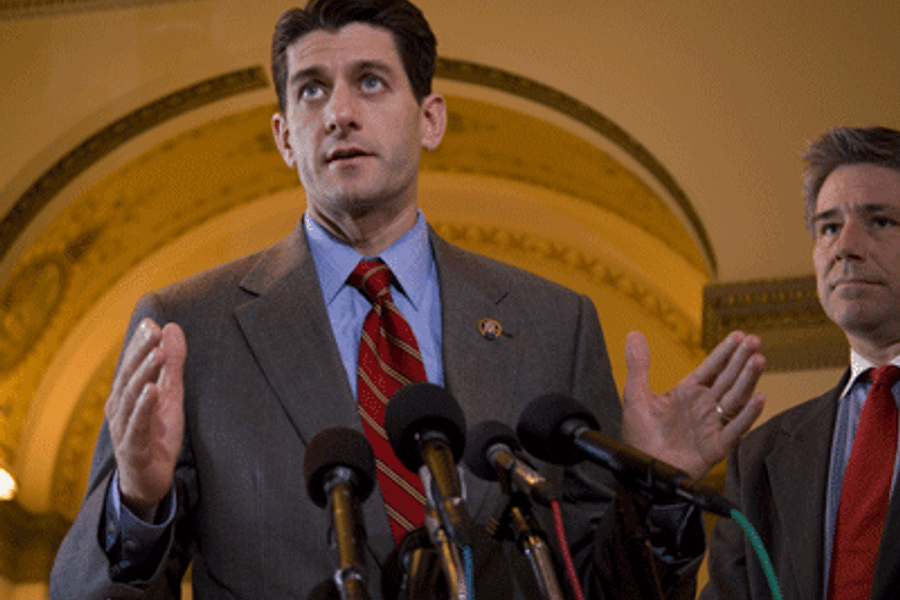
The Republicans believe that they have a winning message ready for the November 2 mid-term elections. According to Congressman Paul Ryan (R-Wis.), it calls for placing a clear choice before the voters: “Are we going to be an opportunity society with a safety net or a cradle-to-grave society with a welfare state?”
Wait a second — what’s causing this sudden flashback to 2008? Wasn’t George W. Bush still stumbling through speeches about the “opportunity society” even as Wall Street was tanking and the economy was headed toward the worst unemployment in 80 years?
Read the fine print of Ryan’s Roadmap for America, they will discover that his “safety net” consists of converting Medicare to an expensive voucher program, privatizing Social Security, and bestowing enormous new tax breaks on the very richest. New York Times columnist Paul Krugman probes beyond the pro-Roadmap hype:
The Tax Policy Center finds that the Ryan plan would cut taxes on the richest 1 percent of the population in half, giving them 117 percent of the plan’s total tax cuts. That’s not a misprint. Even as it slashed taxes at the top, the plan would raise taxes for 95 percent of the population.
Remarkably, the Republicans, despite eight years of disastrous economics and two ugly, unnecessary wars, are still managing to frame economic issues.
The GOP has been aided by a resurgence of cynicism about the ability of government to choose the side of the people over corporate power. “Bailing out Wall Street to save Main Street” — the initial rationale for many of President Obama’s policies — has failed to produce significant relief for ordinary Americans.
HOPELESSNESS SETS IN AMONG THE DESPERATE
Stressed-out families see little prospect of recovery for a number of years, the insurer-written healthcare reform doesn’t start for a couple more years, and the porous Wall Street reforms barely registered in public opinion polls.
Obama’s policies succeeded in preventing a total meltdown that would have pushed official unemployment upwards of 16%. But stopping a train wreck produces little gratitude when the survivors remain trapped in the misery of unstable employment, wage cuts, and anxiety about losing their homes.
As concisely explained by Rob Johnson, director of economic policy for the Franklin Roosevelt Institute,
our government is seen by the population as favoring large institutions and corporate power, not people. Given the choice between perceived corporate welfare that enlarges our future tax burden and curtailing the government, many people now opt for the latter. Not because people lack the desire for services, but because we do not trust our political system to deliver those needed services.
Obama has fed an image of relative indifference to the needs of ordinary Americans while constantly reaching out to major corporate interests and Republicans.
ALIENATING FRIENDS, WOOING ENEMIES
As Krugman has pointedly asked, “Why does the Obama administration keep looking for love in all the wrong places? Why does it go out of its way to alienate its friends, while wooing people who will never waver in their hatred?” (No doubt Robert Gibbs, Ogama spokeman, would insist that a “professional leftist” like Kruman be “drug-tested” for making such comments.)
The outcome of this pattern has been the demoralization of the Democratic base while never-satiated Republicans are fired up for November. As The Economist reported (hat-tip to Art Levine),
The present gap is really more of a chasm. Gallup, a pollster, reckons that a mere 28% of Democrats are “very enthusiastic” about voting, compared to 44% of Republicans. By the same token the Pew Research Centre found in June that only 37% of liberal Democrats were “more enthusiastic than usual” about going to the polls, compared with 59% of conservative Republicans.
‘MADE IN USA’ FOCUS TOO LATE?
Robert Borosage of the Campaign for America’s Future, one of the brightest progressive figures in Washington, remains hopeful that the Democrats’ new programmatic emphasis on rebuilding U.S. manufacturing will help to restore some excitement to the Democrats fall campaign.
A central element in the Democratic battle-plan will be the National Manufacturing Strategy Act, introduced by Rep. Daniel Lipinski (D-Ill.) which calls for reviewing a wide range of government procurement, research and tax policies to rebuild the productive base.
Since 2000 alone, the US has lost 5.6 million manufacturing jobs, 32% of its industrial base. Borosage notes that the public is deeply concerned over these losses:
More than 75 percent of Americans support a “national manufacturing strategy to make sure that economic, tax, labor and trade policies work together to help support manufacturing in the U.S.”
But it remains to be seen how effective the Lipinski plan will be in exciting an electorate turned sour by a too-weak stimulus, the auto bailouts that actually accelerated off-shoring of jobs to Mexico and China, and foreclosure-prevention plans that have been worse than useless.
Moreover, a new wave of “free-trade” talk by the Obama Administration has proposed labor-opposed “free trade” deals with South Korea, Colombia and Panama, as discussed here and here.
While the new emphasis on restoring America’s productive base through energy-efficient products, as discussed by Borosage, is to be welcomed, it remains to be seen how seriously these belated proposals will be viewed by the public. Equally important will be how vividly the public will recall the ruinous Bush years.
OUT OF TOUCH WITH WORKERS
With Obama’s favorability dropping in the polls at a rate “among the sharpest ever recorded for a newly elected president over his first year,” pundits keep asking: “What’s wrong with the Democrats?”
Thomas Frank, author of What’s the Matter with Kansas? and The Wrecking Crew, provided the answer in a bitingly commentary that is all too true:
The answer to the riddle is as plain as the caviar on a lobbyist’s spoon.
Democrats don’t speak to angry, working-class people because a lot of them can’t speak to angry, working-class people. They don’t know how.
Many of the party’s resident geniuses gave up on that constituency long ago, preferring instead to remodel their organization as the vanguard of enlightened professionals and the shrine of purest globaloney.

I hope you found this article important. Before you leave, I want to ask you to consider supporting our work with a donation. In These Times needs readers like you to help sustain our mission. We don’t depend on—or want—corporate advertising or deep-pocketed billionaires to fund our journalism. We’re supported by you, the reader, so we can focus on covering the issues that matter most to the progressive movement without fear or compromise.
Our work isn’t hidden behind a paywall because of people like you who support our journalism. We want to keep it that way. If you value the work we do and the movements we cover, please consider donating to In These Times.







